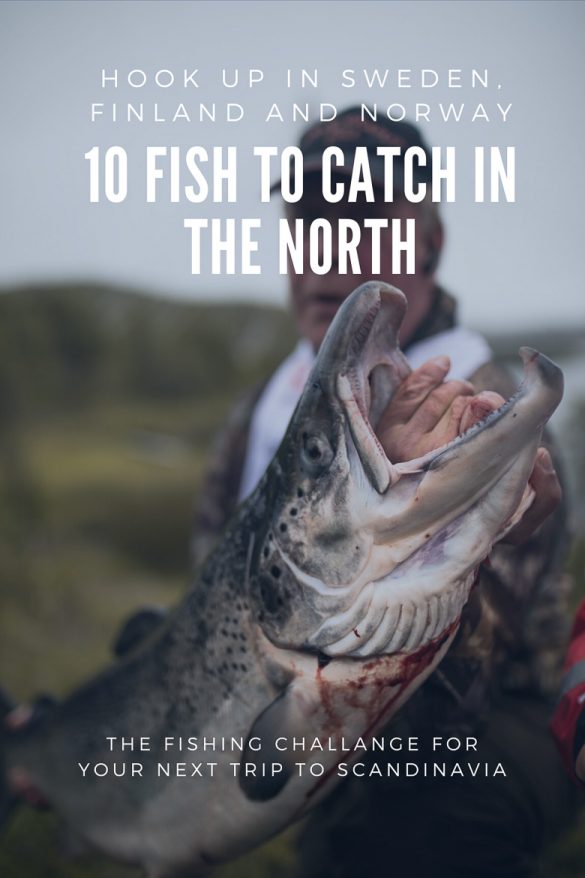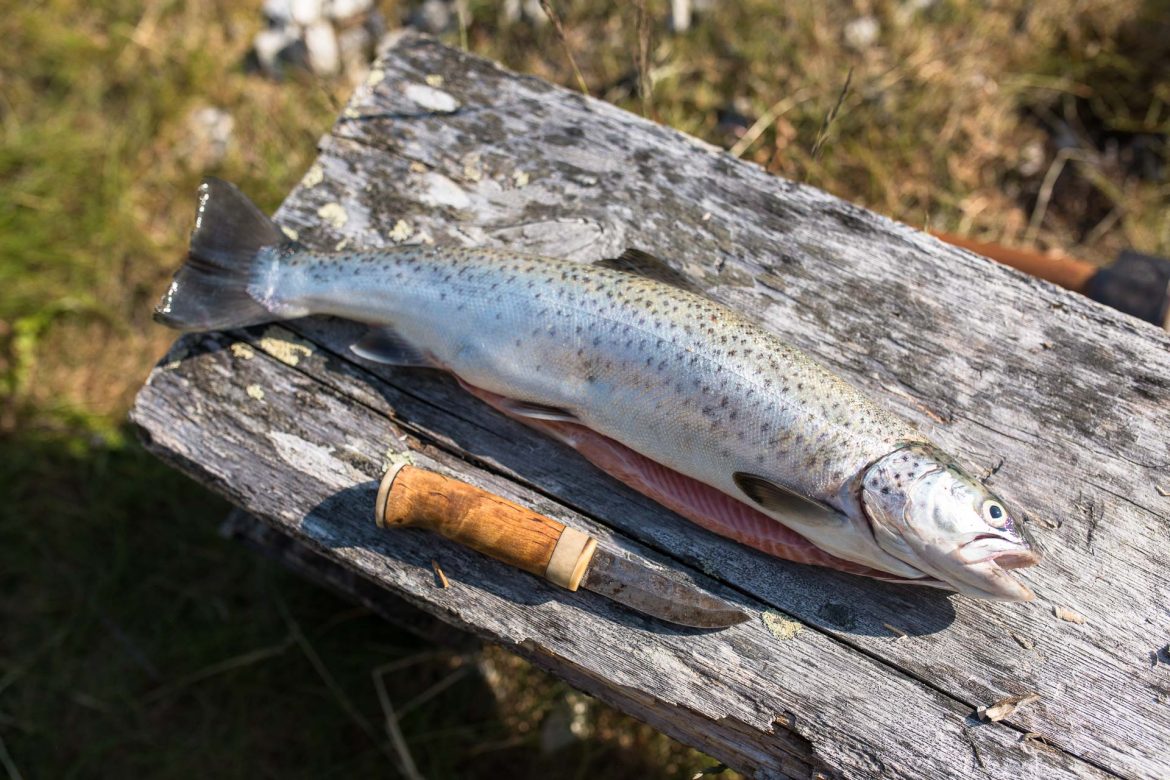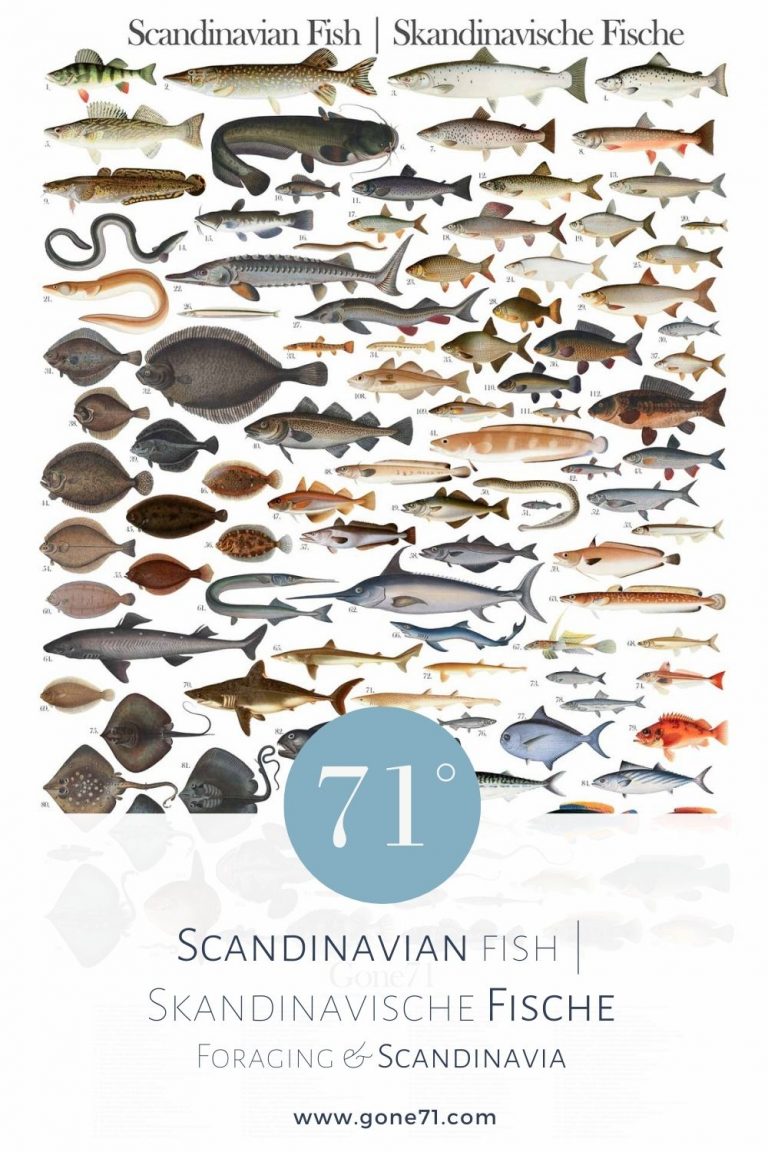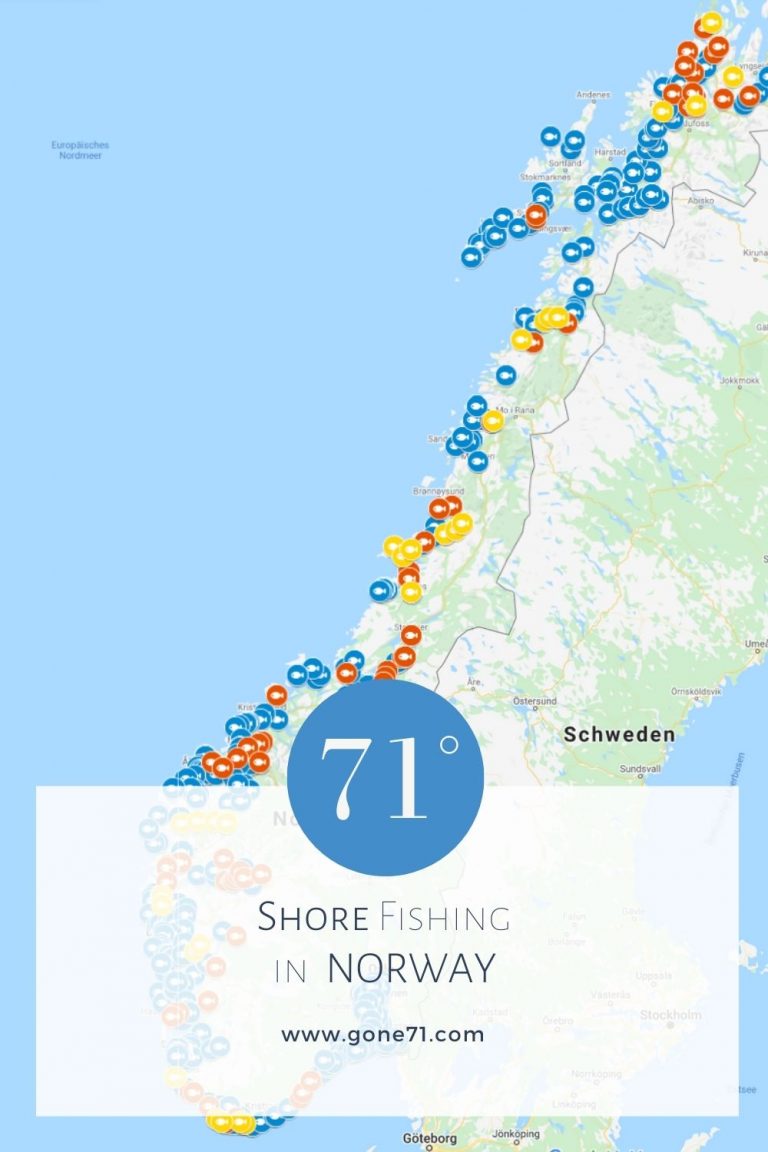No matter if you are looking for a proper challenge on your upcoming trip to the North or if you just want to get better insights on the fish of your dreams – here you’ll learn all about the who is who of Scandinavian fish.
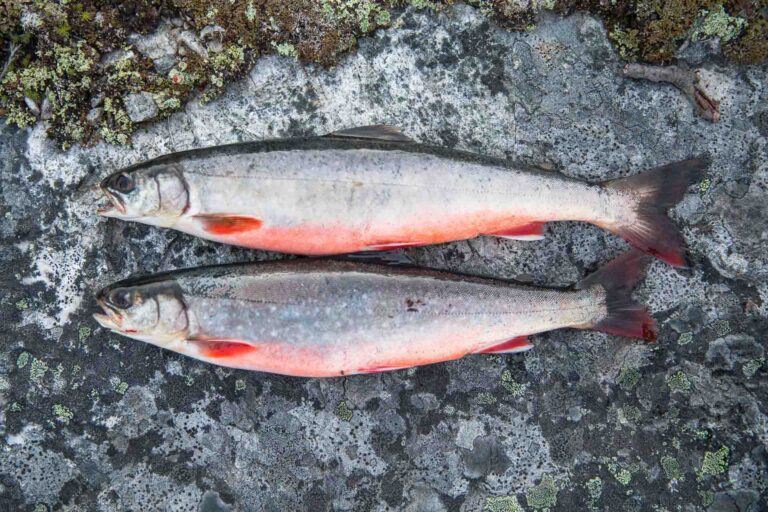
Arctic Char (salvelinus alpinus)
(nor.: røye; swe.: röding; fin.: rautu/nieriä; dt.: Saibling)
The magnificent Arctic char is not only one of the most stunning fish but also well-known for the red bellies that male specimens develop when they mature. Additionally, it is one of the most delectable species swimming in northern waters, and highly sought after by chefs. As the fish has a slightly higher fat content than its salmonid counterparts, it is very suitable for frying.
However, before you can savor this delicious fish, you must first catch it – which can be a challenge in itself. Arctic char thrive in extreme conditions, and are the only freshwater fish species found above 80° North (the parallel of Spitsbergen). They mostly inhabit cold alpine and arctic waters, and healthy populations can be found in the mountain regions of Swedish and Finnish Lapland, such as the area of Kilpisjärvi, and especially in the northern mountain lakes of Finnmark in Norway.
Arctic char can be caught by fly and spin fishing during the summer, and ice fishing during the winter. They can reach impressive sizes, with specimens over 10 kg (20 pounds) not uncommon, although in Scandinavia, a 5 kg fish would be considered a great catch. The species mainly feeds on snails, plankton, chironomids, as well as smaller char and other fish. During the summer, they primarily feed on caddis flies, chironomid, and scud, making dry flies a great way to catch them. However, a spinning rod can be just as effective or even more so, especially when fishing from the shore in lakes.
For basic techniques, insights and fishing rules check our step by step guide – Catch a fish in Scandinavia and Finland
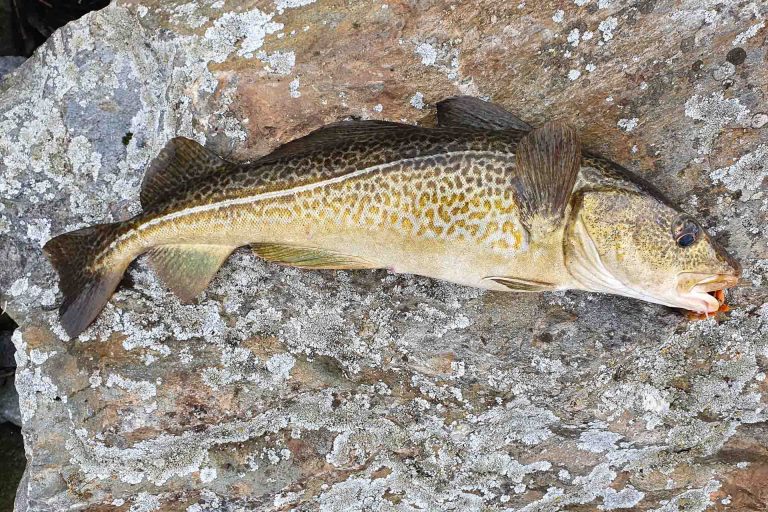
Cod (Gadus morhua)
(nor.: torsk; swe.: torsk; fin.: turska)
From a commercial standpoint, cod is the most significant fish for the Scandinavian fishing industry. No other fish is as closely tied to northern, especially Norwegian culture, as cod, with a relationship dating back over 10,000 years. Norway boasts the world’s largest cod stock, and it has been not only a primary food source but also a trading commodity since the days of the Vikings. Since cod is ideal for drying, it can be transported easily all over Europe and, eventually, the entire world.
There are two main types of cod: Norwegian-Arctic cod and coastal cod. The latter spends its entire life in coastal areas, while the former travels deep into the Barents Sea. Arctic cod is also the backbone of the Norwegian fishing industry, and when it returns for the spawning season (January to April), it does so in vast numbers.
Traveling around the northern coastal parts of Norway from Lofoten upwards, you will come across massive wooden frames filled with more or less dried cod in many places. This fish lives close to the bottom and prefers deeper waters that are best reached by boat, but it is also possible to catch them from the shore if you are not looking for the big trophies. Cods weighing over 40 kg (80 lbs) are caught every year. The prime destination for big cod fishing is Lofoten. Every year in March, the World Cod Fishing Championship is held there, gathering around 600 competitors from all over the world.
If you want to go fishing on your own without a boat, Saltstraumen Bridge is an excellent place to catch bigger fish. If you are fishing for smaller cod for dinner, you are usually better off looking for piers, moles, and natural spots like rock formations that give you access to deeper waters.
When it comes to equipment, a spinning rod in the medium range is usually the best choice. A range of 20g to 50g will suffice if you are fishing for smaller fish from the shore. Otherwise, you might look for something in the 50g to 150g range. Use a braided mainline, with 20lb to 30lb suitable for most purposes.
Grayling (Thymallus thymallus)
(nor, swe.: harr; fin.: harjus; dt.: Äsche)
This freshwater fish is a member of the salmon family and is characterized by its silver-grey scales and shimmering dorsal fin, also known as “the sail”. Grayling thrive in cold, clean, running riverine waters and are widespread throughout the northern regions of Scandinavia, with some of the best fishing grounds located in Finnish and Swedish Lapland. Trophy-sized grayling usually weigh around one kilogram, but catches up to 2 kg are caught every year.
The good news for anglers is that grayling are generally receptive to biting. In our experience, fly-fishing is more effective than spin fishing for this species. If you are new to fly-fishing, targeting grayling in Lapland is an excellent way to start. With some simple tweaks, you can even repurpose your spinning rod for fly-fishing. The season typically opens towards the end of May, and wet flies are the preferred method during this time. Later in the summer, dry flies work best. If you’re not looking for the biggest fish, really small black dry flies can provide plenty of joy and sustenance, especially during the summer. For those who prefer spin fishing, smaller spinners, spoons, and jigs work well. The best grayling fishing areas for purists are located in the wilderness, far from the beaten path, in the backcountry of Lapland.
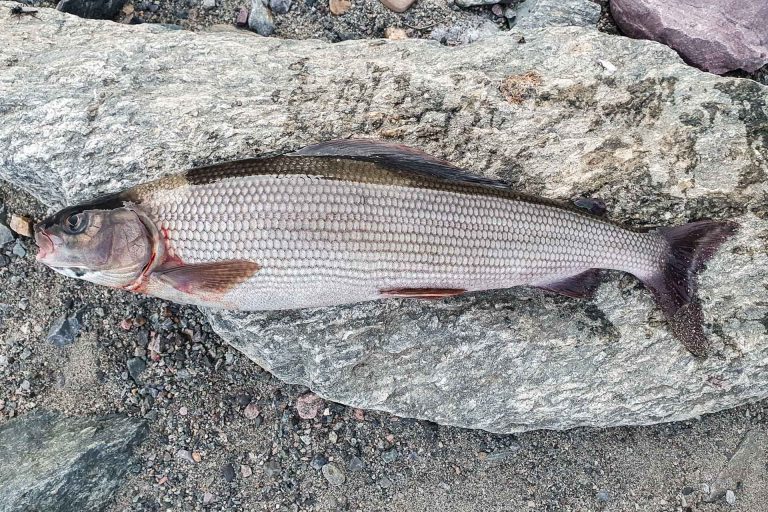
Perch (Perca fluviatilis)
(nor.: abbor; swe.: abbore; fin.: ahven; dt.: Barsch)
The perch is a common predatory fish found throughout Scandinavia, except for the northernmost regions. It is particularly popular in southern Scandinavia where it can grow to a large size, with the Swedish record weighing in at 3.15 kg. Even a 1 kg perch can be considered a lifetime catch. They can be found in rivers, lakes, and the brackish waters of the Baltic and Bothnian Sea, particularly in the Finnish archipelagos. Perch can live for many years, and even seemingly small specimens can be several years old. They are considered a delicious table fish.
Perch are aggressive and will bite throughout the day, with morning and evening being the best times. The most effective technique for catching perch is jigging, but spinners and spoons also work well. You can also catch them using classic hook, bait, and floater methods. Look for spots with deeper waters, drop offs, and natural or man-made objects where perch like to take cover.
Skeppsbron in the old town of Stockholm is a prime destination for perch fishing, and the best part is that no license is required to fish there since it is considered a coastal sea area.
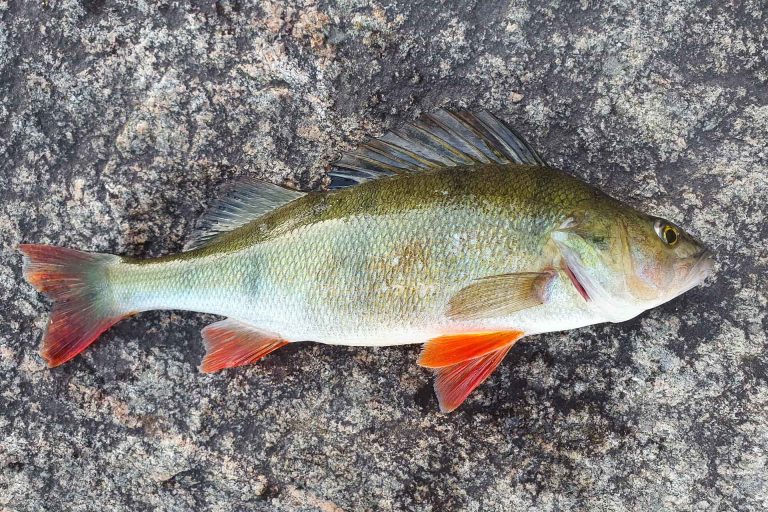
Pike (Esox lucius)
(nor.: gjedde; swe.: gädde; fin.: hauki; dt.: Hecht)
The Russian author Sergei Aksakov famously wrote in 1847 that “The greediness of pike knows no bounds”. In Sweden, pike is known as the “crocodile” due to its torpedo-shaped body and hundreds of razor-sharp, backward-pointing teeth. It is a well-camouflaged predator that is capable of tackling fish larger than itself and is even rumored to have swallowed whole ducks when it reaches its maximum size of one and a half meters.
The best fishing grounds for pike in Europe can be found in the lake land of Finland, but they can also be found in the southern parts of Sweden. While many Finns despise the taste of pike due to its white, flaky meat, it is considered a delicious game fish by many locals in the south who appreciate its willingness to take lures. A one-meter pike is generally considered a respectable trophy, but specimens weighing up to 20 kg are caught every year.
Pike can be found in pretty much all types of water, from lakes and rivers to the brackish waters of the Baltic and Bothnian Seas. They can be caught year-round, but autumn (October until ice) and spring (April and May) are the best times to catch them, as they tend to feed heavily after spawning during these periods. When the water gets warmer, bigger pike will move into deeper waters.
The most common way to catch pike is by spin fishing, but trolling and vertical jigging are also popular methods. Vertical jigging is particularly effective for catching big pike in open waters and typically produces the biggest catches.
Their white firm flesh features some Y-shaped bones, which are easy to remove if you bake the fish as a whole (e.g. at a campfire). We consider pike as great tasting fish and if you have to feed a lot of people it is a great fish to host a feast. Its meat is very juicy when well cooked/baked and there are several possibilities to enjoy this fish.
Whatever you do – keep your fingers away from their teeth at all time if you want to keep them in one piece!
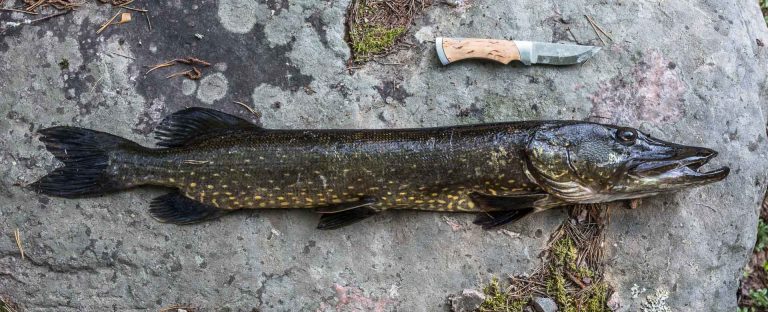
Pikeperch or Zander (Sander lucioperca)
(nor.: gjørs; swe.: gös; fin.: kuha)
Zander are a type of fish belonging to the perch family, but they grow much larger. They are highly valued for their delicious taste, but they can be challenging to catch. They are typically caught by trolling or jigging from a boat in the deeper parts of lakes, but they can also be caught from shore in certain locations. Zander can be found in the Tampere region and lake land area of Finland, as well as in parts of Sweden and the brackish waters of coastal areas.
Zander prefer murky water and tend to live in the deeper areas of lakes and rivers. They are most active during twilight and can be found closer to the surface during this time. During warmer summer days, they tend to stay closer to the bottom, and depths of up to 30 meters are not uncommon.
While spin fishing for zander is possible in some places, vertical jigging and trolling are more common. Trolling can be easily done using a rowboat, one or more rods, and a few lures. Using floating lures is advisable as they rise to the surface when the boat slows down and can avoid getting stuck on any bottom-dwelling obstacles. The sinking depth of different lures varies, so it’s best to have a variety of lures with different sinking depths. A sonar is recommended for vertical fishing.
The best season for zander is usually June and July, but they can be caught in summer and autumn as well. It’s important to note that there are minimum catch sizes for zander that vary by country and region, with the minimum size in Finland usually being 42 cm.
If you’re new to fishing, zander may present a challenge, but they are well worth the effort. If you manage to catch one, they make for a tasty and welcome guest at the dinner table or campfire.
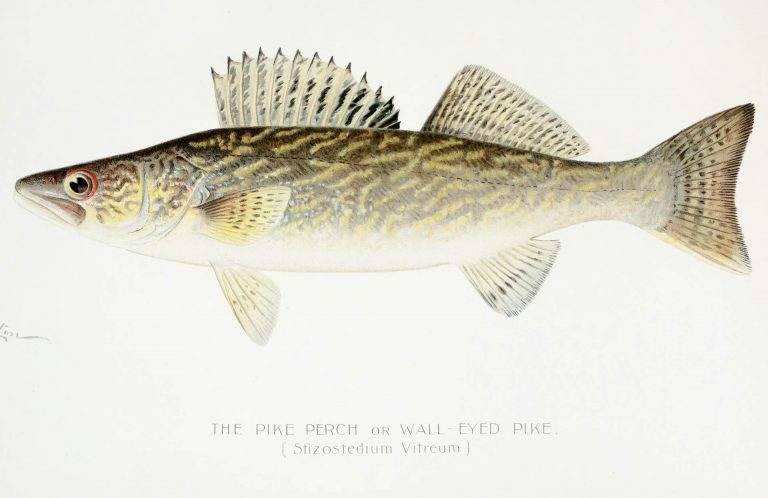
Find top Fishing Spots in Finland – Top Fishing Destinations in Finland | with map
Saithe or Coalfish (Pollachius virens)
(nor.: sei; swe.: lyrtorsk; fin.: seiti ; dt.: Köhler/Seelachs)
Saithe, also known as pollock or coalfish, is a salt-water fish that belongs to the same family as cod. It is an important commercial fish in Norway and is easily caught from the shore in coastal areas, especially in the northern regions.
Saithe is a powerful swimmer and is able to navigate even the strongest currents in Norway, such as the Saltstraumen maelstrom. These fish can be found in large numbers and sizes in this area. Saithe feed on herring, sprat, krill, and other small fish that move through the water.
It is a versatile fish and can be cooked in various ways. It is often used in traditional Norwegian dishes such as fish cakes and fish soup. The flesh is white and firm with a mild taste, making it suitable for various cooking methods such as grilling, baking, and frying. It is also a good source of protein and omega-3 fatty acids.
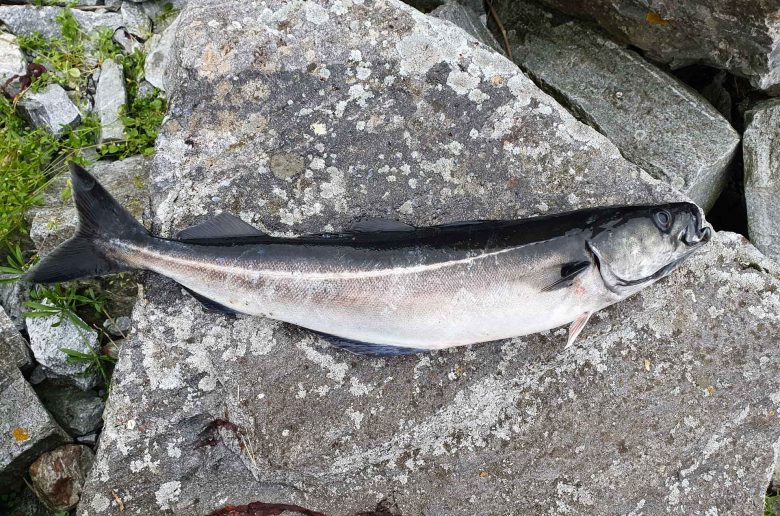
Saithe can be caught all year round along the Norwegian coast. This salt-water fish is a beloved staple of traditional Norwegian cuisine, and is commonly served in a variety of grated fish dishes, such as fish balls or dumplings. Although you may have tasted the flavor of saithe from the frozen packets at your local supermarket, nothing quite compares to the taste of a freshly caught saithe cooked to perfection. Unlike its bottom-dwelling relatives, such as cod, saithe can be found hunting closer to the surface, making it an easier target for fishermen. Although it may not be as prized as salmon, saithe is still a tasty and satisfying catch that is free to catch.
Salmon (Salmo salar)
(nor.: laks; swe.: lax; fin.: lohi)
The Atlantic salmon, also known as the king of fish in the North, is a highly sought-after species that requires advanced techniques and equipment to catch. With strict regulations and licensing requirements, it’s not for the faint of heart or those looking for a cheap catch.
Anglers must be prepared to invest significant time and money to pursue this majestic fish, which can grow up to over a meter in length. You might also need some more advanced techniques and equipment if you want to play with the big boys. The latter quite literally in fact since you’ll find yourself mostly accompanied or even competing with a vast amount of fellow fishermen and –women professionally equipped down to the bone – an intimidating experience by itself.
Unlike its Pacific counterpart Atlantic salmon survive spawning and migrate between river and sea several times. Some of the best salmon rivers in the North include the Tana river, Lakselv, and Alta river, but acquiring a license can be costly and regulations are stringent. In Norway, gear disinfection is also mandatory. Alternatively, Finnish tributaries such as the Utsjoki offer good salmon and grayling catches with licenses available for purchase at local supermarkets. Although lure fishing is allowed in some areas, fly fishing is often the preferred method of catching salmon. For those with more disposable income, there are many premium spots to consider.
If your budget is tight or you do not want to bother with a license,you can try your luck st aome of the Norwegian straumen.There you can fish from the shore without a license. Just make sure to research the specific straumen beforehand and follow local guidelines to ensure a safe and successful fishing experience.
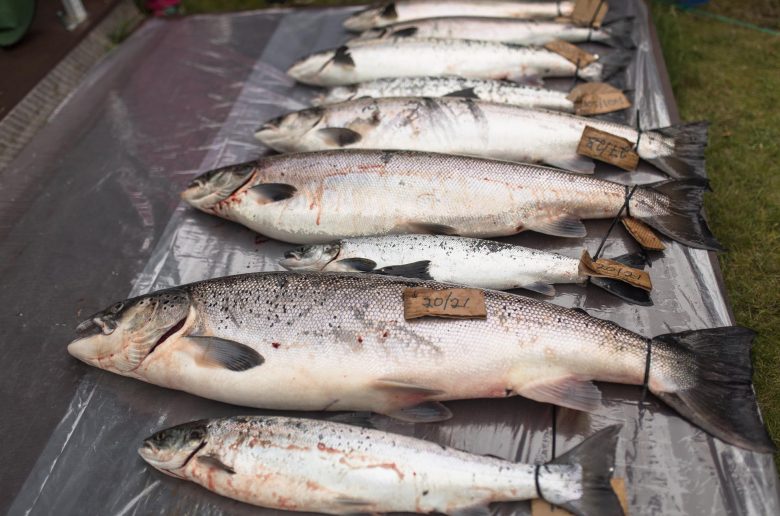
Sea Trout (Salmo trutta trutt)
(nor.: sjøørret; swe.: havsöring; fin.: meritaimen; d.: Meerforelle)
Sea trout is actually a freash water fish and basically a form of brown trout that converted to an anadromous (migrates on a regular basis between river and sea) lifestyle.
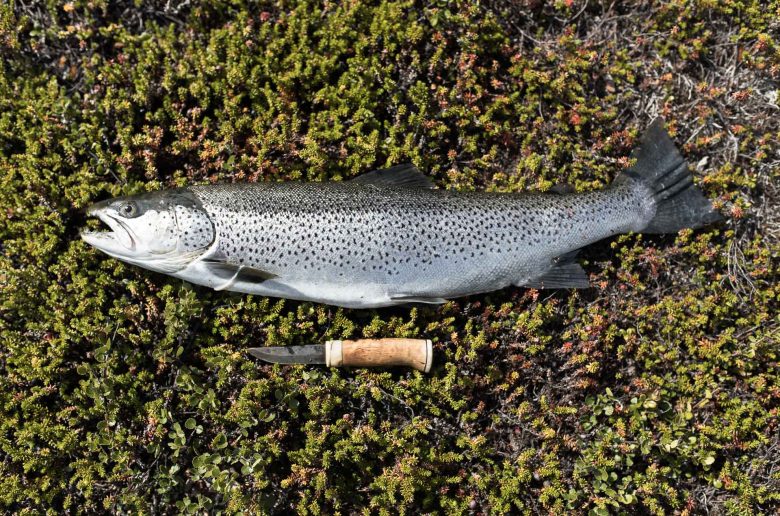
Sea trout fishing from the coastal shore can be a rewarding experience, but it’s not an easy catch. The good news is that you can do it for free and without a license. However, there is a minimum size of 35cm that must be met in order to keep your catch. Sea trout closely resemble salmon and can grow much larger than river trout. To distinguish them, look for features such as a straight tail fin and the position of their eyes. They are typically caught in brackish coastal waters with low salt content, and spring and early autumn are the best times to fish for them.
Sea trout are known for torpedoing out of the water to catch insects, making them a great game for spin fishing, fly fishing, and trolling. A spinning rod is often the most common way to catch them from the shore but in the more shallow areas a fly fishing rod will be the favourable choice. A range of lures weighing 10g to 30g, along with a rod, reel, and line, should be sufficient to get started. There is an infinite number of lures to choose from, but it’s best to switch through your stack until you find what works best for you.
Sea trout have red meat similar to salmon and are a delicious fish. All fjord areas in Norway are suitable for sea trout fishing, but the most promising areas are those close to the rivers. Be aware of regulations on how close to a river you can fish, with the estuary usually being off-limits.
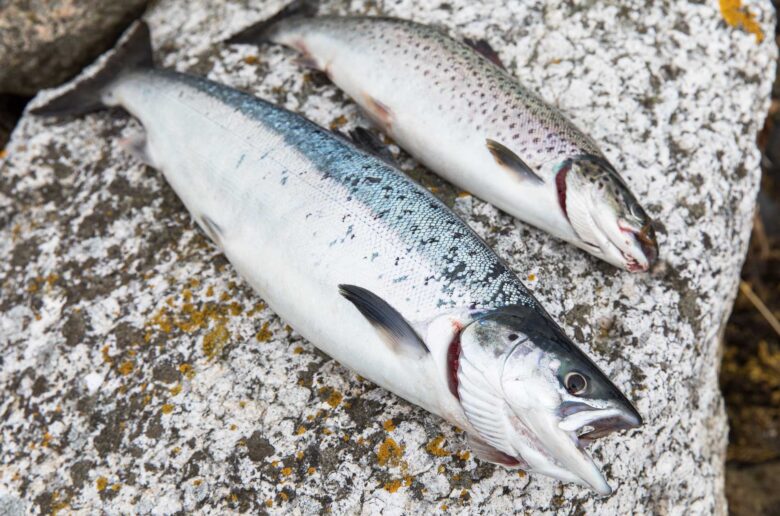
Trout (Salmo trutta)
(nor.: ørret; swe.: öring; fin.: taimen; dt.: Forelle)
Trout is one of the most popular fish in Scandinavia due to their adaptability to various habitats. While brown trout dwell in freshwater rivers, lake trout are lake-locked and sea trout are migratory. Despite their different habits and habitats, they all belong to the same species of fish, but can vary in appearance and size.
Brown trout, in particular, are highly sought-after by anglers for their power, hard fighting, and ability to torpedo out of the water. Native brown trout are mostly found in Lapland, but in other parts of Scandinavia, they are stocked in popular fishing rivers for sport fishing purposes. The distinguishing feature between a native brown trout and a stocked fish is the clipped adipose fin, which is the second, smaller dorsal fin. In regions outside of Lapland, fish with adipose fins must be released, and regulations are strict.
The best fishing season for trout depends on the location. For river fishing, April and May are usually good months when the stoneflies hatch. Later in the summer, night fishing can be productive, considering the long daylight hours in the north. Trout are mainly caught by lure or fly fishing, and different strategies may be required depending on the location. When using spin fishing, red-colored lures such as wobblers, spinners, and spoons often work well.
Rainbow trout (Oncorhynchus mykiss) is another species of trout that can be caught in Scandinavia. However, rainbow trout are not native and are always cultivated fish stock. Finland is known for having many small lakes and rivers that offer the possibility to catch rainbow trout. In rivers, they are typically targeted using colorful lures such as flies, spinners, spoons, and wobblers, while in lakes, colorful artificial paste bait, known locally as silicon, is used. Rainbow trout is mainly targeted for sport fishing, and opinions are divided on the introduction of non-native fish to the region.
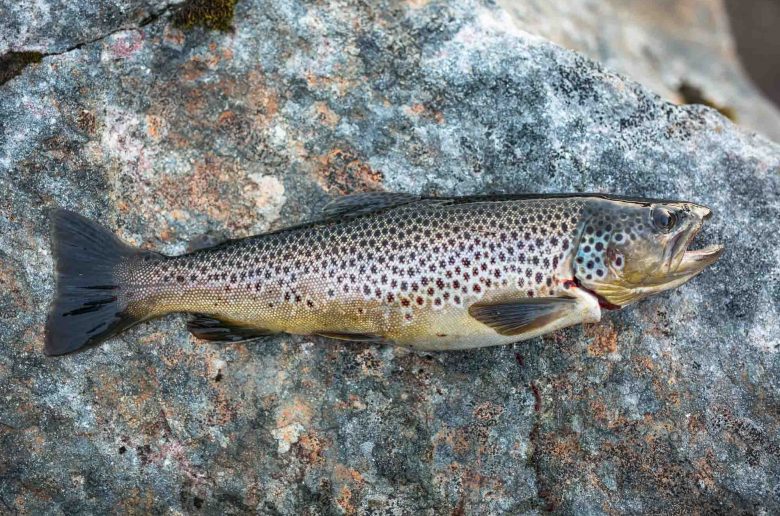
Find more inspiration on Scandinavian fish here
↓↓↓
